
The United Kingdom actively engages in several national and international environmental and climate change initiatives, including the UK Emissions Trading Scheme (ETS), which replaced the UK’s participation in the EU ETS on 1 January 2021. The Paris Agreement under the United Nations Framework Convention on Climate Change (UNFCCC). And several decarbonisation initiatives, one of the main subjects of debate at Davos 2023.
Even without the European Union’s involvement, the UK must uphold its international environmental protection and climate change obligations. Let’s look at some of the most pressing environmental concerns in the UK, the steps to address them, and how you can get involved.
Overview
In 2021, the British Parliament passed the Environment Act as the country’s new environmental protection framework. This Act helps fills the gap to improve air and water quality, protect wildlife, increase recycling, and reduce plastic waste. The Act is part of a legal framework for environmental protection, and the UK has left the EU, includes:
- Interim targets and delivery pathways in the Environmental Improvement Plan
- Setting various environmental goals
- Significant legal duties for public bodies to consider environmental principles in policymaking
- A new Office for Environmental Protection (OEP)
- Extending producer responsibility systems for waste and granting authorities to control inefficient resource use in products
- Adding a “biodiversity net gain” condition to the grant of planning permission, along with associated powers for new conservation covenants
- Strengthening air quality legislation and increased enforcement powers, with mandatory recalls for vehicles and equipment failing environmental tests
- Imposing restrictions on businesses that use agricultural commodities derived from deforestation
The Environmental Protection
The government of the UK introduce environmental laws that are primarily for England. The National Assembly for Wales is the legislative body with authority over all other matters about Wales.
The Welsh government is responsible for formulating environmental policy for Wales, except for matters within the UK government’s legislative competence. Here we’ve provided a list of some of the most important departments concerning environmental protection and links that will take you through each of them in far greater detail to help you better grasp them.
- The former Department of Business, Energy, and Industrial Strategy (BEIS) typically deals with climate change issues.
- The Department of Environment, Food, and Rural Affairs (DEFRA) are primarily responsible for environmental policy and drafting environmental legislation.
- The Environment Agency (EA) or Natural Resources Wales (NRW) in Wales is the main group responsible for issuing permits and ensuring they are followed. However, in some cases, these tasks are done by the local government.
- The Office for Environmental Protection’s (OEP) job is to keep an eye on how environmental laws are being implemented. This is mostly to replace the European Commission’s oversight role after the UK left the EU. If the violations are serious, the OEP can take action and seek legal redress in the courts (by way of Environmental Review).

EU now is growing more regulations on environmental protection over the years.
The EU environmental principles provide structure and meaning to laws and protect our natural world by guiding judges and policymakers. Many governmental and public authority decisions rely on them, such as land use applications, the administration of marine preserves, and the mitigation of polluted areas.
DEFRA Environmental Target
The idea of a 25-year environment plan came from a report from an independent committee that advises the government, Natural Committee Capital, in March 2014. The report said the government should set up a 25-year plan to protect and improve natural capital.
Then, the government agreed with this suggestion. Defra published its former single departmental plan (2015-2020) in February 2016. This plan included a framed commitment to a 25-year plan for the environment.
Defra is the main contributor to shaping the regulatory landscape in environmental protection.
The government is working towards a long-term vision of a healthier, more sustainable, and more resilient environment. Achieving these goals will require concerted effort and collaboration across different sectors and communities.
Aims of the Plan
On January 31, 2023, the UK government released its Environmental Improvement Plan 2023 (EIP). This is the first change to the 25-Year Environment Plan (A Green Future: Our 25-Year Plan to Improve the Environment), originally released in 2018. To restore and sustain environmental quality over the next quarter-century, the 25YEP outlined a plan of action.
To reach its vision, the 25YEP set 10 goals. It shows the progress made on all ten goals, the specific targets and commitments made for each goal, and how they plan to keep meeting the targets and achieving the overarching goals.
- Thriving plants and wildlife
- Clean air
- Clean and plentiful water
- Managing exposure to chemicals and pesticides
- Maximise our resources, minimise our waste
- Using resources from nature sustainably
- Mitigating and adapting to climate change
- 8.Reduced risk of harm from environmental hazards
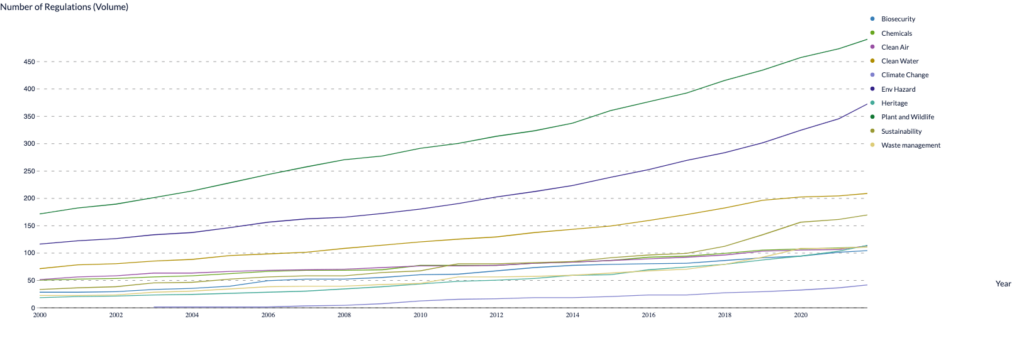
Looking at the regulations on all these aspects in the past 20 years, gradually increasing.
The EIP notes that ” the food we eat, the air we breathe, and the water we drink, all of which are essential to human survival, all depend on thriving, diverse and species-rich ecosystems”. The natural environment in the UK and elsewhere has been under stress from a number of human activities, including agricultural management, climate change, urbanisation, pollution, hydrological change, invasive non-native species, and woodland management. Cohesively, these components are a prime target for the EIP.
Clean Air
Several core policies (detail below relating to domestic air emissions, industrial air emissions, agricultural air emissions, and transportation air emissions) are needed to help reach the EIP’s clean air goals. More than 85% of PM2.5, 87% of nitrogen oxide, and 90% of ammonia emissions are produced by just four polluting sectors, including our homes, agriculture, industry, and transportation.
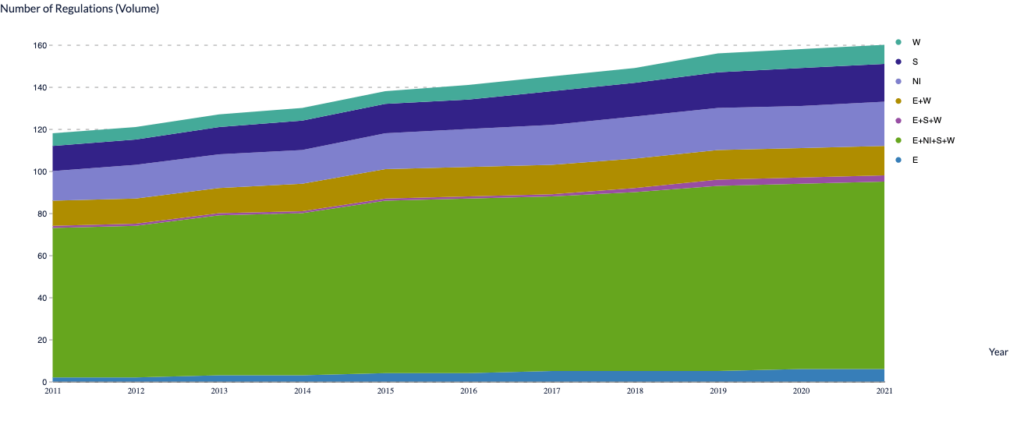
As shown in the chart above, most of the regulations apply to all 4 UK regions (i.e. E+NI+S+W), while some regions have their own regulations.
Domestic air emissions
Improving regulations for burning high-emission materials like wood and manufactured solid fuels (MSF) will be the primary focus of domestic emission reduction policies. The EIP acknowledges that a ban on domestic burning in England is not in the cards, but regulations will be tightened, such as limiting the sulphur content of MSF, restricting the sale of wet woods, and re-evaluating the enforcement of local smoke control areas.
Industrial air emissions
Using the Best Available Techniques (BAT), large-scale industrial air emissions have been steadily decreasing for quite some time. With this success in mind, the government is eager to expand BAT to include new technologies and implement methods for businesses, as well as to transfer this information to smaller industries that are frequently located in urban areas and near residential areas, where improvements in emissions standards could have very positive outcomes.
Agricultural air emissions
The EIP explains that the government will identify best – practices for emissions reductions, which may be more onerous depending on their specific locations, such as next to a sensitive nature site, and that these regulations will be applied to some agricultural sub-sectors.
Producing biogas via anaerobic digestion (AD) results in the emission of ammonia, which is toxic to aquatic life, but the AD by-product is used as a substitute for chemical fertilisers. The EIP declared that the government would explore technologies to treat digestate and thereby decrease ammonia emissions in light of the growing popularity of AD and its likely increased deployment towards 2030.
Transportation air emissions
The transportation sector is responsible for a large portion of the decrease in emissions, but it still contributes significantly to overall nitrogen dioxide and PM2.5 emissions. The introduction of clean air zones in cities across the UK and the restriction on the sale of new petrol and diesel-fuelled vehicles as of 2030 are just two of the high-profile policies introduced to combat these emissions.
The government has laid out a lot of its plans in its Transport Decarbonisation Plan, which was released in 2021. The policy solutions contained within are large in scale, creating a lot of room for commercial innovation and delivery. The government is working towards a world-class charging infrastructure network, planning to deliver thousands of miles of cycling paths, and planning to invest in research into technologies that will reduce brake dust and tyre emissions, which affect electric vehicles just as much as they affect gas- and diesel-powered vehicles.
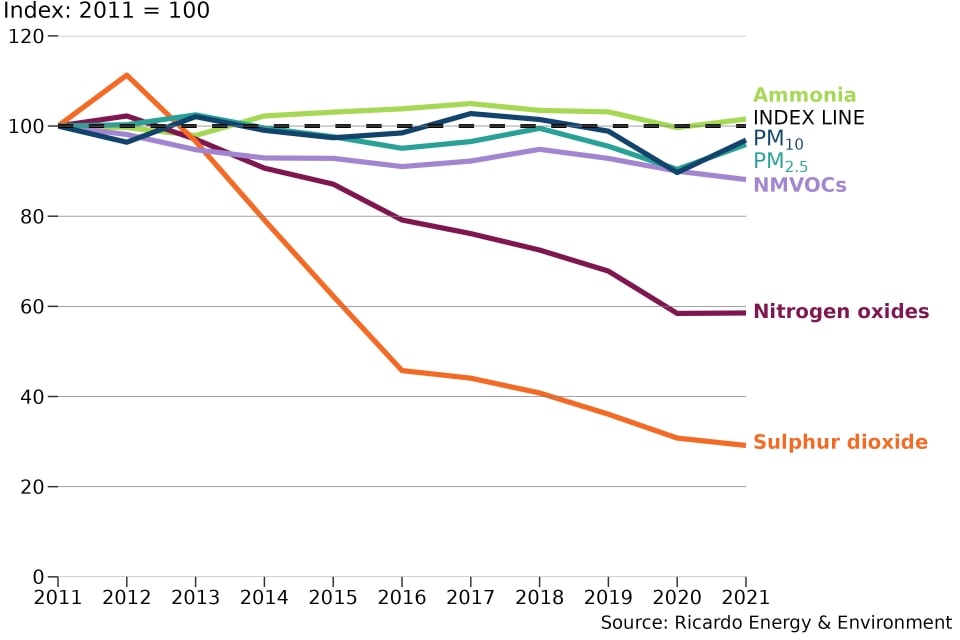
Looking at the above chart, it is reducing a lot in Nitrogen oxides and Sulphur dioxide, but for Ammonia, PM10 and PM 2.5, it still stays at a similar level.
Greenhouse gas emission by sector
From the chart below, it’s easy to see how many different industries and processes are responsible for global emissions. This means that there is no easy or effortless way to combat global warming. It’s not enough to just worry about energy, transportation, food, or forest loss.
The UK emissions in 2021 are estimated to be 425 million tonnes of carbon dioxide equivalent (MtCO2e). There would be less carbon dioxide (CO2) emissions if natural gas were used instead of coal to generate electricity because coal produces more CO2 per unit of electricity than natural gas. The energy-supply industries reduced their use of fossil fuels by 63% and the manufacturing industries by 52% between 1990 and 2020. However, transportation and storage increased their use of fossil fuels until 2019 (up 28%), but then decreased in 2020 due to the COVID-19 pandemic.
The majority of emissions are carbon dioxide (an average of 81% from 2016 to 2021). As a result, shifts in CO2 tend to be reflected in shifts in GHG emissions. Since 1990, when emissions total 809 Mt CO2e, they have decreased by 47%.
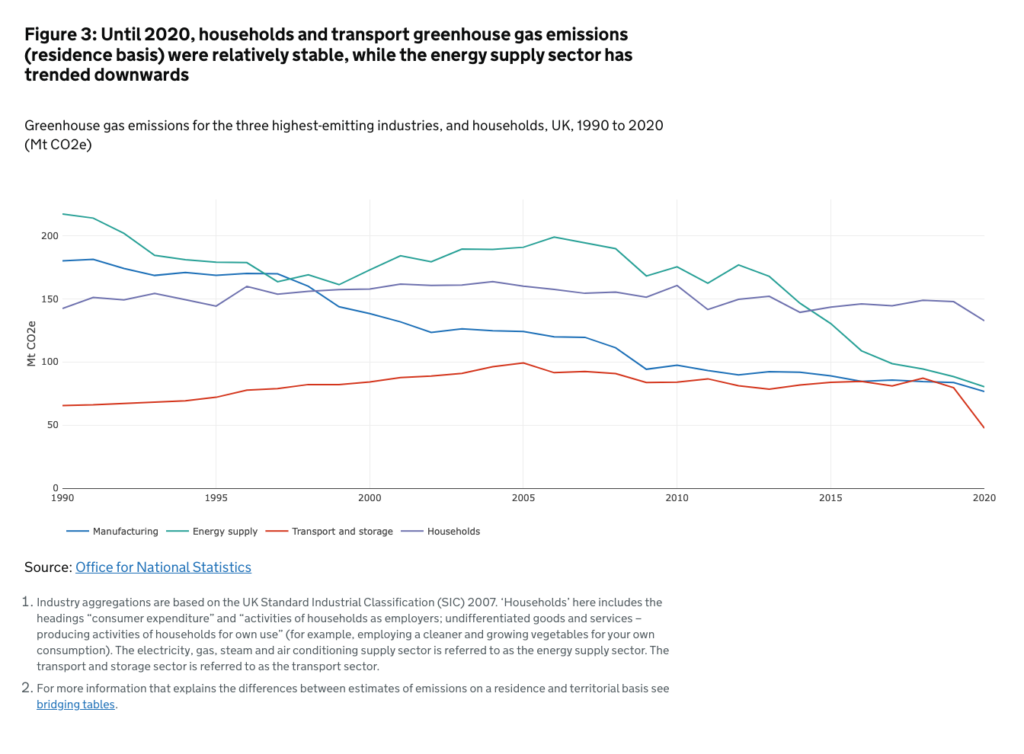
Households and transport greenhouse gas emissions (residence basis) were relatively stable, while the energy supply sector has trended downwards.
It’s not easy to reduce emissions, even in the energy industry, which is responsible for nearly 75% of all manmade pollution. To fully decarbonise our electricity supply, we would also have to electrify all of our heating and road transportation systems. And that’s without considering the emissions from shipping and aviation, for which we currently lack low-carbon technologies.
Achieving zero emissions requires breakthroughs in a wide range of industries, and it will require more than just one solution.
Climate Change
The Climate Change Act of 2008 forms the basis of the UK strategy for mitigating climate change and adapting to its effects. The framework is supported by legally binding emission reduction goals for 2050 and the next 15 years.
To achieve a net-zero reduction in greenhouse gas emissions by the year 2050, the UK government is required by law to enact policies consistent with the Climate Change Act. A significant portion of the United Kingdom’s emissions come from the devolved administrations (Scotland, Wales, and Northern Ireland), so lowering those emissions is a priority. The CCC’s 2019 report, titled “Net Zero – The UK’s contribution to stopping global warming,” provided the rationale for the ambitious 100% goal.
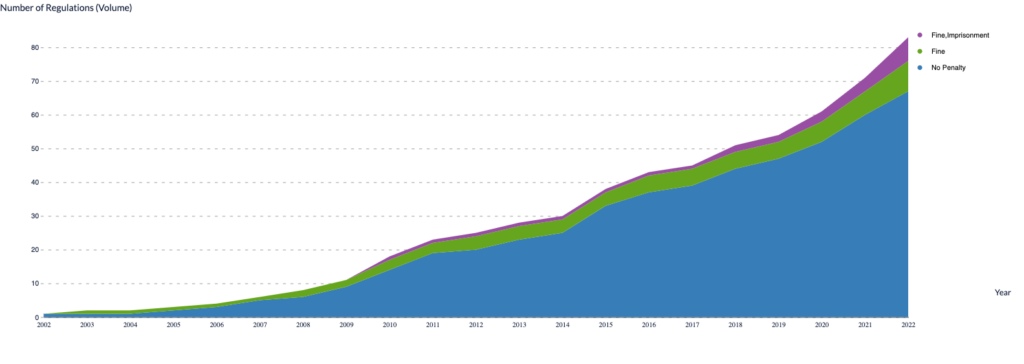
The amount of regulation about climate change in the UK about climate change has been increasing in the past 20 years. The majority of them don’t have a penalty, while a small proportion of them have a fine or imprisonment as a penalty.
Climate change regulation by departments
The Prime Minister has also established a Cabinet Committee on Climate Change. Subcommittees will help to make sure the government as a whole is thinking about and acting on climate change. Every government agency is tasked with considering climate change as part of its deliberations before settling on a course of action. Climate change is the responsibility of two main UK government departments: Former BEIS and DEFRA
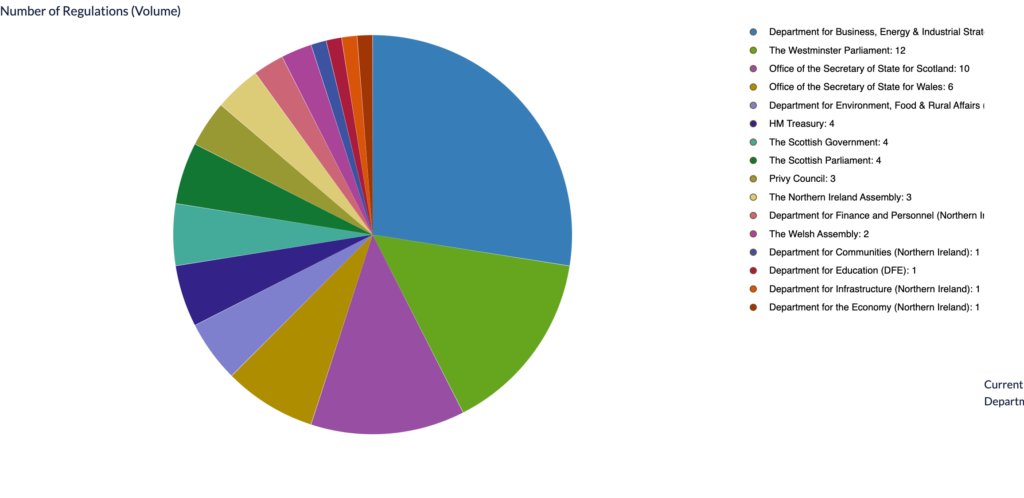
Look at the departments that make up the regulations in climate change
Devolved administrations
- In 2009, Scotland passed the Climate Change (Scotland) Act, which set a “Net Zero” emissions goal for 2045. The targets are 56% by 2020, 75% by 2030, and 90% by 2040, all relative to the base year. Also, a requirement is the development of a Scottish Climate Change Adaptation Programme.
- The Welsh government has a new obligation under the Environment (Wales) Act 2016 to establish carbon budgets for Wales and achieve an 80% reduction in emissions by 2050. In 2020, the Welsh Government will follow the Committee’s recommendations and present regulations to the Assembly in order to change Wales interim targets and carbon budgets in preparation for the year 2050.
- The Northern Ireland Executive is working on a new Energy Strategy and plans to write to the Committee for input on how the province can better contribute to the UK goals of achieving Net Zero greenhouse gas emissions by 2050.
In order to effectively combat climate change, policymakers at all levels of government, businesses, and the general public need a long-term coordinated framework that can provide them with clarity and direction. Decisions about climate policy should be made by representatives in Congress after careful consideration of the available evidence.
However, there should be no disagreement about the importance of addressing the climate challenge and many different perspectives on how to do so. The continuation of climate action would be bolstered by drafting this requirement into law.
Summary and policy advice
Environmental laws and how they’ve been enforced have varied greatly between countries, pollution sources, and periods of years. Studying previous regulations to make informed decisions requires careful analysis of the regulatory context to ensure comparability, which policymakers often overlook.
Law Notion recognises the importance of effective environment protection regulation and the need for a coordinated framework to combat climate change. Law Notion -Reglytica is a powerful regulatory analytics platform that helps policymakers navigate complex environmental regulations and stay updated. With Reglytica, you can access a vast database of environmental laws and regulations and analyse their impact, and you can plan a draft proposal based on requirements and environmental needs.
If you’re a policymaker or member of the general public who cares about the environment, we encourage you to take action to support a long-term, coordinated framework for addressing climate change and to enshrine this requirement into law. Contact Law Notion.
